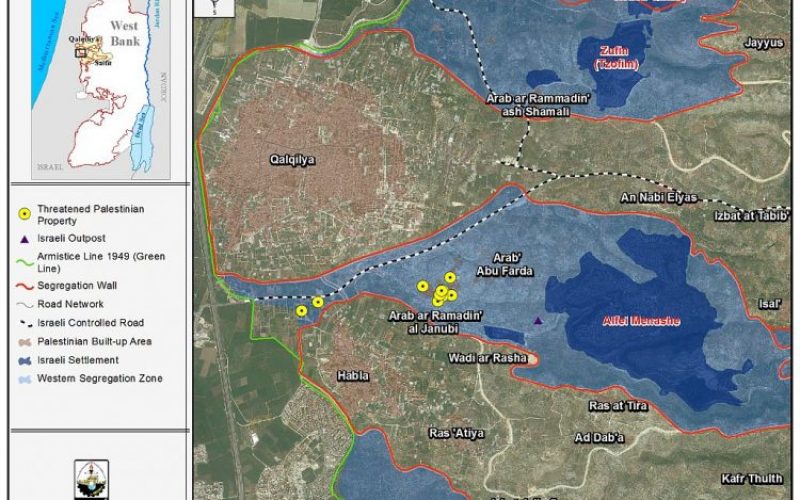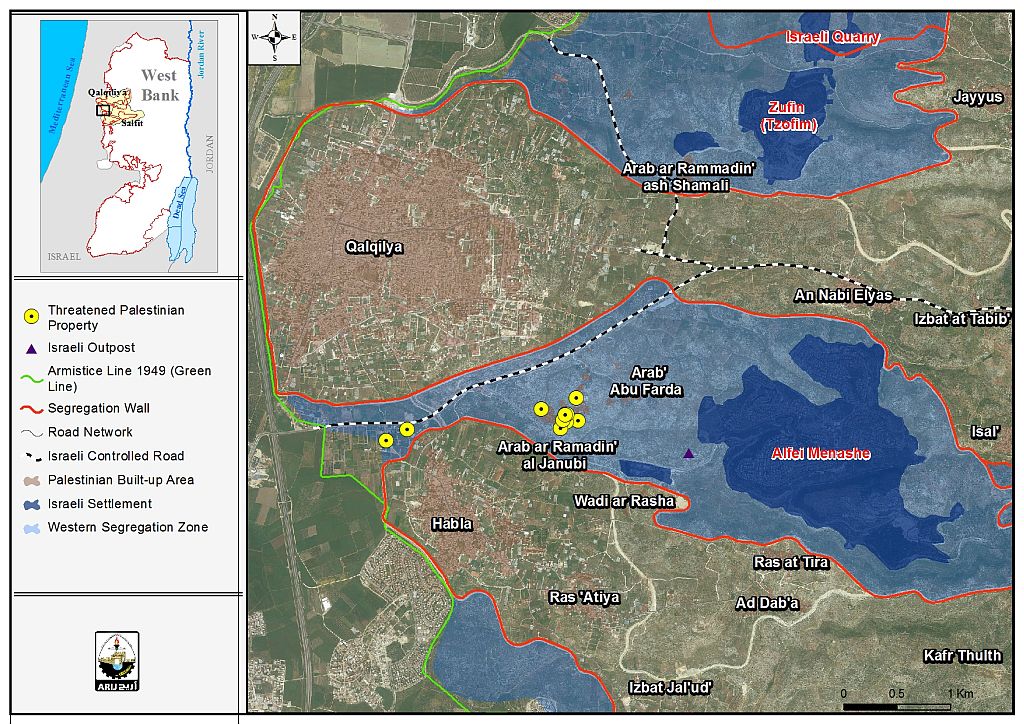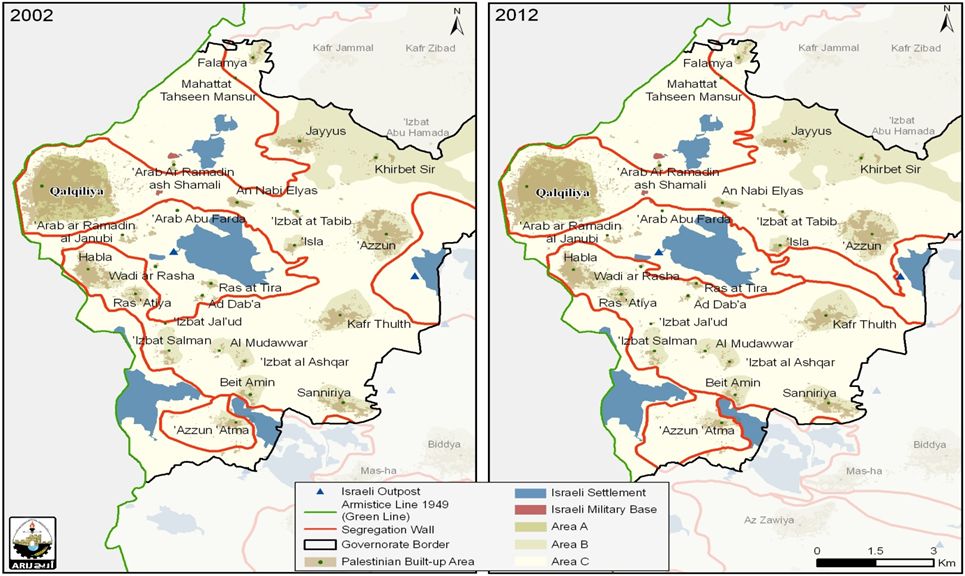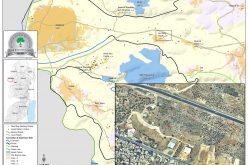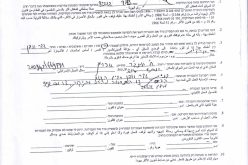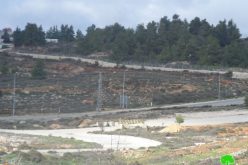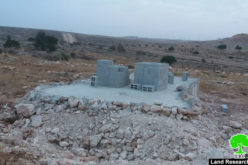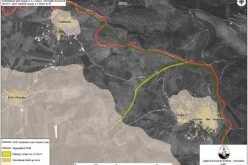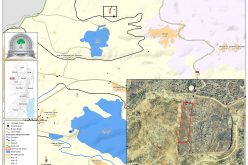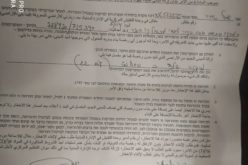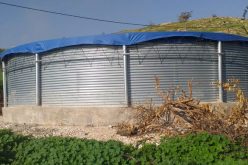The suffering of the Palestinian Bedouin communities in the occupied West Bank is ongoing as the Israeli occupation Authorities is moving steadily in its war against relocating these communities in all West bank areas with the aim to make room for its colonial expansions. On the 19th and 21st of July 2016, the Israeli Civil Administration handed over Palestinian Bedouins in ‘Arab Ar Ramadeen Al Janubi southeast of Qalqilyia city halt-of-construction orders for their primitive homes and structures under the pretext of lacking building permits. Of the received orders, 10 families were targeted in the village including 2 others in Habla village.
As usual, the orders stated that the received demolition orders were built/installed in violation of the fourth chapter of the Israeli City, Village, and Building Planning Law no. 79 of 1966 which was amended after the 1967 war by the Israeli Occupation Authorities on the basis of Military order No. 418 to comply with Israel's interests and settlement plans in the occupied Palestinian territory. The Israeli Civil Administration gave Palestinian families of Arab Ar Ramadeen Al Janubi till the 4th of August 2016 to proceed with license procedures. However, they also pointed out that pursuing license procedures does not guarantee Palestinians a license by the Israeli civil administration as stipulated in the Order or stop possible demolition during that time. Table 1 gives detailed description of the halt-of-construction orders in ‘Arab Ar Ramadeen Al Janubi along with a copy of the received halt-of-construction orders:-
| Table 1: Detailed description of the halt-of-construction orders that targeted Ar Ramadeen Al Janubi Bedouin community in Qalqilyia Governorate | |||||
| No | M.O. No. | Owner Name | Area (sq²) | Property Description | Status |
| 1 | 201662 | Abdullah Nayef Abed Abu Sho'or (July 19) | 100 | Under construction home | Hal of construction order |
| 2 | 201664 | Muhamamd Nayef Sho'or (July 19) | 100 | Under construction home | Hal of construction order |
| 3 | 201659 | Muhamamd Salameh Khalil Sho'or (July 19) | 40 | Room | Hal of construction order |
| 4 | 201663 | Nayef Abdullah Sho'or (July 19) | 300 | Animal Farm | Hal of construction order |
| 5 | 201669 | Omar Ali Omar Odeh (July 21) | 100 | Hal of construction order | |
| 6 | 201667 | Ashraf Hasan Khalil Sho'or (July 21) | 60 | Room | Hal of construction order |
| 7 | 201666 | Ahmad Mu'taz Sho'or (July 21) | 100 | Under construction home | Hal of construction order |
| 8 | 201665 | Jameel Mo'taz Sho'or (July 21) | 100 | Under construction home | Hal of construction order |
| 9 | 201077 | Ahmad Suleiman Sho'or (July 21) | Final Demolition Order | ||
| 10 | 201668 | Nabeel Hussein Ali Muwafi (July 21) | 60 | plastic House – shading roof | Hal of construction order |
| Source: Qalqilya Directorate 2016 | |||||
Map 1: Threatened structures in ‘Arab ar Ramadin al Janubi
‘Arab ar Ramadin al Janubi
A Palestinian village in the Qalqiliya Governorate located south of Qalqiliya City. It is bordered by ‘Arab Abu Farda village to the east and by Qalqilyia city to the south, west and north (ARIJ-GIS, 2016) (see map 1). According to the Palestinian Central Bureau of Statistics (population projection 2007-2016), the population of ‘Arab ar Ramadin al Janubi in the year 2015 is 270.
According to the Oslo II Interim Agreement signed on 28th September 1995, by the Palestinian Liberation Organization (PLO) and Israel, all the village lands of 'Arab ar Ramadin al Janubi were classified as area C and consisted of 438 Dunums. This classification means that Israel retains full and extensive control over security and administration related to the territory, and land management is prohibited without the prior consent or authorization of the Israeli Civil Administration.
The construction of the Israeli Segregation wall and its effect on Arab Ar Ramadeen Al Janubi
The first map which was published by the so-called Israeli Ministry of Defense in April 2002 showed that the segregation wall would completely isolate the village of 'Arab ar Ramadin al Janubi and other neighboring Palestinian villages such as Arab Abu Farda, Wadi Ar Rasha and Ras Tira and Ad Dab’a in an enclave by surrounding them with the wall from the northern, southern and eastern sides, leaving only the western side open; however bordered by the 1949 Armistice Line (See Map 3). The map also showed another segregation zone created due to the construction of the wall (to the south) and includes the villages of Habla and Ras Atiya, (See Map 2).
Map 2: Comparison between the path of Israeli Segregation Wall plan in 2002 and 2012
Since 2002, there were several amendments to the path of the Segregation wall in the West Bank. In particular further changes were made on the route of the wall mainly on the 20th February 2005, 30th June 2006, and on the 30th of April 2007. 'Arab ar Ramadin al Janubi was not among those villages which saw amendments to the Wall route and the village still suffers until this day from the construction of the Segregation Wall on its territory as the village remained isolated from its surrounding villages, mainly , the center of life in Qalqiliya city (to the north-west).
Additionally, for the people in 'Arab ar Ramadin al Janubi to communicate with their surrounding Palestinian communities, the Israeli army installed a gate at the main entrance of the village, and on the Israeli bypass road No. 55. This iron gate was established after the completion of the Segregation Wall in the area, and only the villagers of 'Arab ar Ramadin al Janubi and 'Arab Abu Farda were allowed to enter and exit through the gate, which is the only space connecting the village to the city of Qalqilyia and the neighboring Palestinian villages from the eastern side and the Israeli soldiers control the movement of the Palestinians who are passing through this gate.
Israel claims that the goal behind the construction of the segregation Wall in the occupied Palestinian territories is for security reasons, however Israel is seeking to isolate Palestinian communities or even relocate others from their places where best suits its colonial ambitions. Israel is also taking advantage of the uninhabited spaces nearby to construct roads and expand settlements and even reserve land for future settlement activity in an effort to undermine the development of the Palestinian communities in the future. In our case, the settlement of Alfei Menashe is a typical example. While Israel is targeting Arab Ar Ramadeen Al Janubi and other communities nearby with demolition orders, it is exerting limitless efforts to expand the settlement of Alfei Menashe. Several plans were prepared and issued for expanding the settlement since its establishment. See Annex 1:-
Previous demolitions in Arab ar Ramadin al Janubi
- In June 2008, the Israeli Civil Administration proceeded to submit a master plan that ordered the displacement of 'Arab ar Ramadin al Janubi residents. The plan suggested several alternative areas for the residents to relocate to. The residents were told they had to leave the village, and would be provided with basic services such as electricity and water in the new areas that were proposed. Residents rejected the plan, and since then, the Israeli army started to exert pressure on the community through controlling their movement and access to land.
- On the 9th of July 2008 the Israeli Civil Administration (ICA) handed over halt-of-construction orders to eight Palestinian families in the village to stop the construction of these buildings under the pretext of illegal construction since the targeted buildings are located in Area C. The threatened homes and structure included two kitchens, one house, one residential room, and a grain store. They belonged to the following names: Younis Jabr Khalil and Maher Salim Al-Sha’or.
- On June 25th 2009, the Israeli civil administration (ICA) ordered to deport the residents of 'Arab ar Ramadin al Janubi from its place which is adjacent to the settlement of Alfei Menashe. The ICA wanted to relocate the villagers to an alternative site, outside the wal (east of the wall).
- In June 2009, the Israeli civil administration handed over a number of military notifications to Palestinian farmers in 'Arab ar Ramadin al Janubi which targeted three agricultural barracks and one house, in addition to guesthouse building. These orders were given under the pretext of “illegal construction”. These buildings belonged to the following citizens: Kamel Salamah Sha’or, Younis Jabr Sha’or, Kasab Bajes Sha’or, and Maher Salim Sha’or.
- In September 2010, the Israeli civil administration notified four Palestinian families living in 'Arab ar Ramadin al Janubi halt-of-construction orders to their homes which are made of wood and tin. The orders were given under the pretext that the buildings were constructed without permits in the area classified as “Area C”. The military orders targeted 3 agricultural barracks , a house and a stone often (Tabun) which belongs to Kassab Bajes Shao’r and a sense of Maher Salim Sha’or, and Adnan Lutfi Sha’or .
- In February 2012 the Israeli Civil Administration handed over 'Arab ar Ramadin al Janubi military orders to stop the construction work on a number of their residential and agricultural facilities under the pretext of unlicensed construction. The orders targeted two houses and three other facilities which belongs to the Kassab Bajes Sha’or feeling Lutfi and Adnan Lutfi Sha’or.
- In June 2012 Israeli bulldozers targeted 'Arab ar Ramadin al Janubi where they demolished a barn used for cattle which was owned by the citizen Fahmi Kassab Sha’or. The demolition came under the pretext of ‘unlicensed construction’.
Annex 1:-
| Israeli Plans issued for building in Alfei Menashe settlement | |||
| No. | TPS Number | Date of Approval | Purpose |
| 1 | 115/3 | 1985 | Development of 'residence |
| 2 | 115/1 | 1985 | Determination of land use purposes |
| 3 | 115/2 | 1985 | Determining zoning |
| 4 | 115/4 | 1987 | 24 units |
| 5 | א115/1 | 1989 | 2 residential zoning change |
| 6 | 115/1/1 | 1989 | Distribution of plots |
| 7 | 115/6 | 1990 | Determination of land use purposes |
| 8 | 115/2/1 | 1990 | Reparcellation |
| 9 | 115/4/1 | 1991 | Determination of land use purposes |
| 10 | ב115/3 | 1991 | Development of Residential Neighborhood |
| 11 | 115/4/2 | 1992 | Determination of land use purposes |
| 12 | 115/1/3 | 1993 | Determining changes and provisions |
| 13 | 115/7 | 1994 | Area for small industry, craft and commerce |
| 14 | 115/4/2/1 | 1995 | Improving accessibility for land |
| 15 | 115/8 | 1996 | 1406 Units (Alfei Menashe Main Map) |
| 16 | 115/4/1/1 | 1997 | Changing of buildings construction |
| 17 | 115/8/1 | 1999 | Providing additional powers for the purpose of design and construction |
| 18 | 115/16 | 1999 | Residential zoning change |
| 19 | 115/13 | 1999 | Residential zoning change |
| 20 | 115/8/2 | 2000 | Highway access – Givat Tal neighborhood |
| 21 | 115/16/1 | 2001 | Changing the designation of lands (from open paces to Roads) |
| 22 | 115/13/1 | 2002 | Changing maximum area |
| 23 | 115/4/1/3 | 2002 | Building Lines |
| 24 | 115/4/3 | 2002 | Conditions for constructions |
| 25 | 115/16/3 | 2002 | Ease in residential area |
| 26 | 115/13/2 | 2003 | Changing building lines |
| 27 | 115/16/4 | 2003 | Replanning |
| 28 | 115/8/4 | 2005 | Redistribution |
| 29 | 2/ 3/ 115 | 2005 | Changing designation of the area for public residential zone A |
| 30 | 1/ 825 | 2006 | |
| 31 | 115/8/7 | 2007 | Setting Construction regulations |
| 32 | 115/3/1 | 2007 | Construction of Sun shading roof |
| 33 | 115/12/2 | 2007 | Increasing parking space, building shading |
| 34 | 115/13/3 | 2007 | Increasing parking space |
| 35 | 115/16/5 | 2007 | Setting up an internal road system |
| 36 | 115/1/1/4 | 2008 | Changing a building |
| 37 | 115/12/3 | 2009 | Change of main area |
| 38 | 115/8/7/1 | 2009 | 3 units |
| 39 | 115/8/10 | 2010 | stadiums |
| 40 | 115/8/9 | 2011 | Changes in land use |
| 41 | 5/ 3/ 115 | 2011 | zoning from public institutions to Civic Center |
| 42 | 115/8/11 | 2012 | Park zoning change for public zoo |
| 43 | 115/8/6 | 2012 | Changes in land use |
| 44 | 115/8/6/1 | 2013 | |
| 45 | 115/8/8 | 2013 | Changing the designation of special residential integrated way |
| 46 | 115/5 | 2013 | Determining area for sports center |
| 47 | 5/ 8/ 115 | 2013 | NA |
| 48 | אמ/ 12/ 115 | 2013 | NA |
| 49 | 115/12/1 | 2014 | 28 Units |
| 50 | 20/ 115 | 2014 | zoning from agricultural area to residential area, roads and open spaces |
| 51 | 115/17/1 | 2015 | Business Park |
| 52 | 115/21 | 2015 | Private swimming pools |
| 53 | 115/14 | 2016 | 24 Units |
Prepared by:
The Applied Research Institute – Jerusalem


